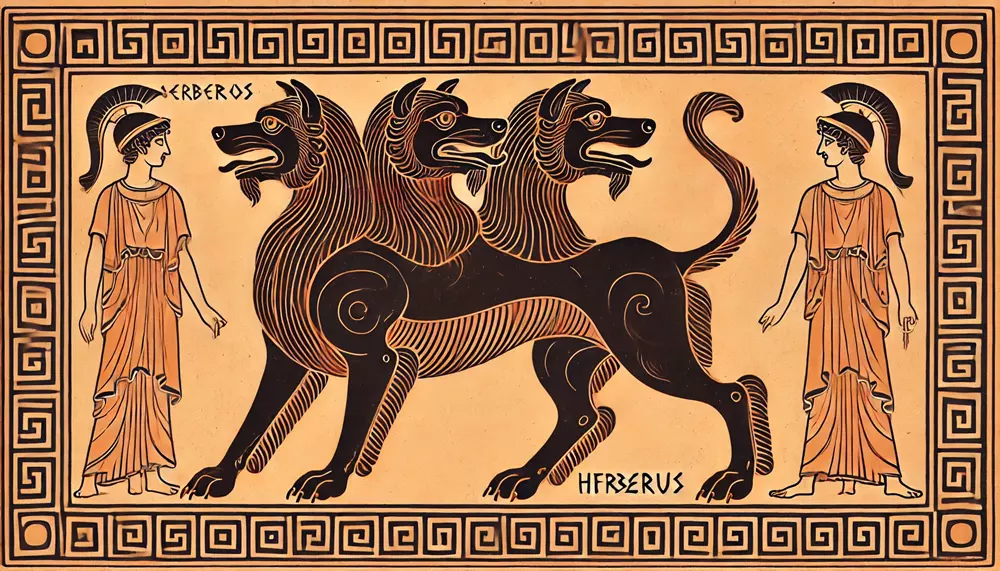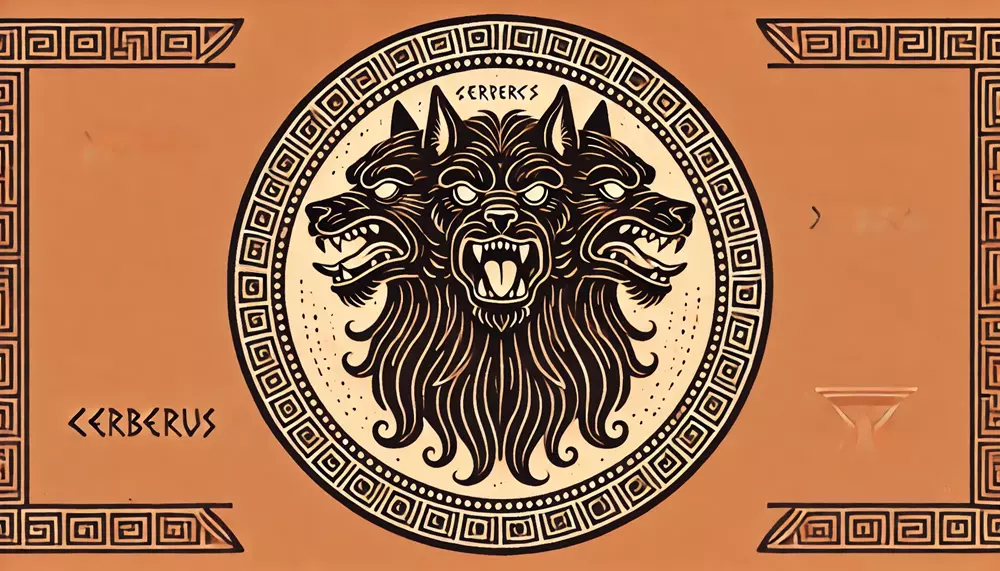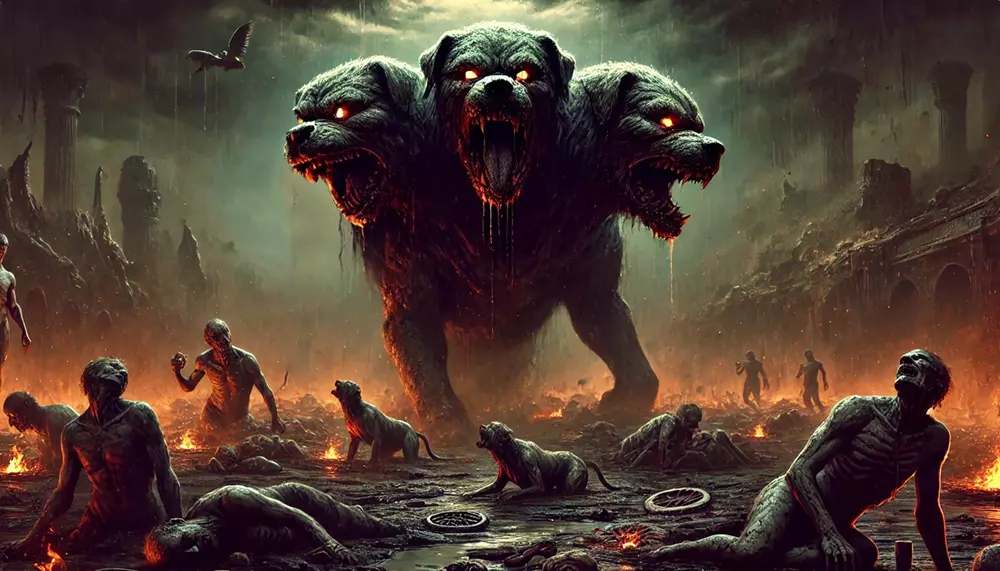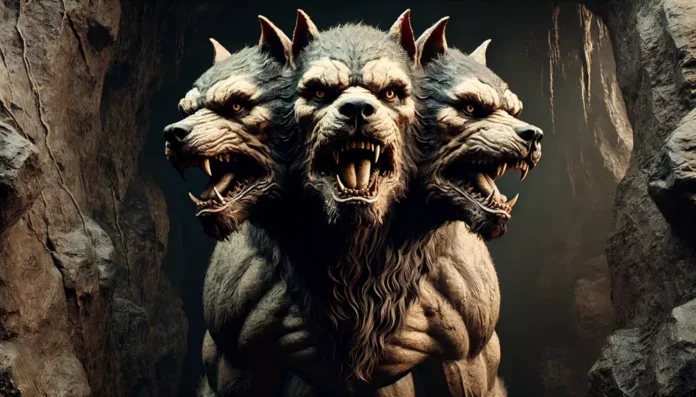Introduction
Cerberus, the legendary guardian of the Underworld, isn’t your average guard dog. This three-headed beast stands watch at Hades’ gates, ensuring no mortal enters—and no soul escapes. With a lineage tied to monstrous figures and loyalty to Hades himself, Cerberus symbolizes both the strength of loyalty and the fearsome power of the Underworld.
Known for his fear-inducing presence and ability to handle countless souls, Cerberus has become an icon of Greek mythology. Yet, beyond the terror, he represents boundaries, the line between life and death, and the unforgiving nature of the Underworld.
History and Origins
Cerberus first prowled his way into Greek mythology through texts like Hesiod’s Theogony, where his lineage marks him as a true beast among beasts. The son of Typhon and Echidna, both monstrous figures in Greek lore, Cerberus inherited the vicious strength and intimidating appearance of his parents. His duty as Hades’ loyal watchdog is a testament to the Underworld’s power and the sanctity of its boundaries.
In one of his early mentions, Hesiod describes Cerberus with “fifty heads and an insatiable hunger for mortal souls.” Though later depictions favor the more manageable image of three heads, Cerberus’ terrifying reputation remains unchanged. Over time, he became a consistent figure in myths revolving around the Underworld, his appearance serving as a warning to those who dare to challenge death itself.
One ancient text sums up his role simply: “Cerberus, gatekeeper of the shades, he who consumes those who dare to trespass”—a fitting description for a creature tasked with eternal vigilance.
Name Meaning
The name “Cerberus” likely originates from the Greek Kerberos, which loosely translates to “spotted” or “demon of the pit.” While the exact origins of the name are debated, many scholars link it to his dark, fearsome nature, as the name embodies his role as the Underworld’s guard.
Other interpretations tie his name to words meaning “harbinger of death,” cementing his association with Hades and the afterlife. In Latin, the name Cerberus carried on in Roman adaptations of Greek myths, spreading his legend far beyond Greece.
Background Story
Cerberus plays a memorable role in several Greek myths. One of his most famous appearances is in the Twelve Labors of Heracles. Tasked with capturing Cerberus alive, Heracles journeys to the Underworld and battles the beast with sheer strength, eventually winning Hades’ permission to take Cerberus to the surface.

While Heracles did succeed, Cerberus was eventually returned to the Underworld, where he resumed his duties. This tale highlights Cerberus’ immense power and reinforces the idea that only the greatest heroes can encounter the Underworld’s guardian and live to tell the tale.
A line from Homer’s Odyssey encapsulates this encounter: “Even the might of Heracles could not tame the beast of Hades without divine favor.”
Similar Beings
Cerberus’ role as a guardian beast aligns him with mythical creatures from other cultures. The Norse Garmr, a hound that guards Helheim, shares his function of preventing the dead from escaping the afterlife. In Egyptian mythology, Anubis, though not a beast, also safeguards the dead, standing at the threshold between life and death.
These beings all embody themes of loyalty, duty, and an unwavering commitment to guarding the boundaries of mortality, linking them across cultures.
Cultural Impact
Cerberus’ fearsome reputation left its mark on ancient Greek culture and beyond. Statues of three-headed dogs were common near temples dedicated to Hades, symbolizing protection against unwanted spirits. Greek warriors would invoke his name for strength before battles, hoping to harness even a fraction of his power.
One Athenian festival, the Anthesteria, was linked to honoring the dead and included offerings to Underworld deities like Hades and Cerberus. In these traditions, Cerberus symbolized respect for the dead and the mysteries beyond life, reflecting a reverence for death’s boundaries that permeated Greek culture.
In funerary art, Cerberus often appears as a symbolic protector of tombs, a reminder of the guardianship he provided to the souls in the Underworld. Sculptures and pottery illustrations of him graced tombs, embodying the idea of eternal vigilance.
Religion and Ritual
In ancient Greek religion, Cerberus was more than just a character in myth—he held a place in the spiritual beliefs of those who worshiped Hades. During rites dedicated to the Underworld, sacrifices were made in Cerberus’ name to appease the spirits and secure safe passage for the deceased.

Even today, Cerberus’ image appears in discussions of the afterlife and spiritual thresholds. Some Neo-Pagan practices still invoke Cerberus as a symbol of boundaries, particularly in rituals that honor the dead. He remains a powerful emblem of the passage to the other side, bridging ancient beliefs with modern spiritual practices.
Scientific or Rational Explanations
While Cerberus’ three heads may seem fantastical, scholars have speculated that his design could be rooted in ancient observations of multi-headed animals, perhaps stemming from congenital defects observed in dogs or wolves. Ancient storytellers might have amplified these unusual features to create the three-headed beast we know today.
The symbolic nature of Cerberus as a guardian dog also aligns with the instinctual role dogs play in human societies. As protectors and companions, they are often stationed as gatekeepers, which may have inspired Greek poets to imagine a canine guardian of the Underworld.
Modern Cultural References
Cerberus remains a beloved figure in modern media, embodying themes of loyalty, fear, and guardianship:
Harry Potter Series – The three-headed dog, Fluffy, guards the Philosopher’s Stone, a clear nod to Cerberus. His presence in Hogwarts symbolizes the same intimidating guardianship as his Greek counterpart.
Dante’s Inferno – In this famous text, Cerberus appears as a punishing figure for gluttons, a depiction that extends his symbolism to include the consequences of unchecked desires.

Hades (Video Game) – Cerberus is a companion to the protagonist, Zagreus, showing a softer, loyal side to the legendary beast, who still guards the gates of the Underworld.
Percy Jackson Series – Cerberus is depicted as an emotional creature, capable of affection, adding layers to his character beyond mere terror.
Resident Evil Franchise – Named “Cerberus,” the zombie dogs in this horror game evoke fear and hostility, inspired by the guard-dog aspect of the myth.
Conclusion
Cerberus endures as a figure that transcends his roots in ancient Greece. He’s more than a beast—he’s a symbol of boundaries, a guardian of secrets, and a reflection of humanity’s deepest fears about life and death. In every retelling, his role as the faithful hound of the Underworld remains unchanged, a timeless image of loyalty and protection in the face of darkness.
As one ancient writer noted, “Cerberus stands as both the final gate and the first welcome to those who enter Hades’ realm.”









